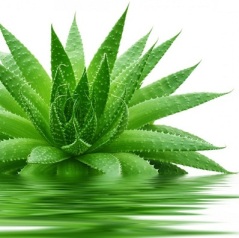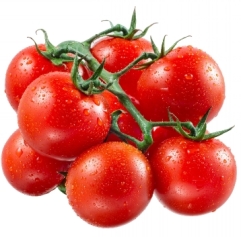
Creating a Cancer-Fighting Indoor Herb Garden
There is something very special about having fresh herbs and spices growing on the windowsill to snip at will, and apart from making food taste great, the medicinal use of herbs and spices have been known for aeons.
Plants tend to lose their cancer-fighting benefits the longer they’re separated from their roots, so it’s ideal to pick herbs fresh and use them immediately in your cuisine.
There is also an emotional aspect to growing herbs yourself – a special purpose and a completed cycle, if you will. There is also a connection to life that is personally fulfilling… the excitement when the seed produces its first leaves and then develops the flowers and finally the fruit.
Growing a windowsill herb garden is also a great hobby that you and your Child with Cancer can enjoy doing together – both you and your child will derive great pleasure from watching them grow and smelling their fresh fragrance.
Herbal remedies have been used to treat both the cancer itself and to ease the side effects caused by conventional therapies. Having a fresh supply on your windowsill is also perfect for making some of those great cancer-fighting, nutritious smoothies.
How to Plan & Grow Your Own Indoor Herb Garden
What You Need to Get Started
- Decide what you want to grow (see below for some plant suggestions).
- Choose a windowsill in a sunny location (south or southwest exposure for six consecutive hours in the day is best).
- Choose the types of pots you would like to use − hanging or windowsill ledge or both.
- Find an organic plant nursery, plant food, a table, newspaper, and a day or two to accomplish the task.
You can go to an organic nursery and pick out the plants that you want to grow as well as to purchase potting soil, compost, humus, organic plant food, pots or window boxes, plant hangers, and a misting bottle.
Putting Your Herb Garden Together
- Gather some pebbles or small rocks to put in the base of the planters and hanging pots. Fill the bottom of each plantar/pot with a single layer of stones – this helps with drainage.
- Mix the soil in a bucket with one part each of compost, potting soil, and humus. (Note: You can also buy some potting soils that already combine all of these elements). Add the soil mixture to the planters, pots, and hanging pots you’ve selected.
- Water all the plants thoroughly, allow them to drain, and make a hole in the potting soil mixture for each plant.
- Place the plants in the planters and press firmly around the base of the plant and soil to set them in the planter.
- Wipe off the pots and planters and place them on the windowsill and/or install the triangular wall brackets for the hanging plants and put them on the hooks.
What Herbs Can I Grow on My Windowsill?
Good choices for a windowsill herb garden include basil, cilantro, dill, oregano, rosemary, sage and thyme. You can start herbs from seed or purchase small plants. Annual herbs are especially easy to start from seed; most perennial herbs take longer to germinate and grow so it’s easier to start with plants.
How do I Plant Herbs in Water?
Basil, mints, pineapple sage, oregano, sage, stevia, thyme, lemon balm, and many other herb cuttings will thrive in a jar of water on your windowsill for months. The only herbs that don’t grow well in water are annual herbs, such as dill and cilantro, which live just long enough to flower and then go to seed
What Herbs can be Grown Together?
Even though rosemary generally prefers different conditions, parsley, rosemary and chives can all be grown together in a window box. Mediterranean herbs: Herbs from this region are the ones who tend to prefer a dry and sandy soil. Sage, thyme, rosemary, marjoram, oregano and lavender all fall into this category.
Ideas for What to Grow in Your Indoor Herb Garden
Aloe Vera
Aloe Vera grows best in a pot on the windowsill or a plant stand near the window – remember the spiky leaves can spread, which may be too wide for the windowsill, so make sure that yu leave enough space.
Aloe Vera is well known for its skin protective and anti-inflammatory properties and can be used for healing the skin from burns, blemishes, and scars. The inner gel is excellent to add to your smoothies (the flavour is unnoticeable) and it heals your internal tissues.
Aloe Vera is great if there is damage from radiation therapy or chemo-induced tissue damage. It has been used successfully for decades as a treatment for cancer. It contains substances called polysaccharides, which boost the immune system and destroy rogue cancer cells.
Aloe Vera also works very well when rubbed on as a topical ointment for cancers (especially skin cancers).
Fighting inflammation is one way to reduce the risk of cancer, but this succulent herb also contains many beneficial polysaccharides such as Acemannan, which can induce the production of Tumour Necrosis Factor that destroys cancer cells. The immune-boosting actions of Aloe Vera include increasing the production of interferon and promoting T-cell function.
Basil
Basil has anti-inflammatory, antioxidant, and tension soothing components, and it also has a very pleasant and relaxing aroma.
Basil is considered one of the healthiest herbs; best when it is fresh and exuding its sweet, earthy aroma that indicates not only the promise of pleasantly pungent flavour, but an impressive list of nutrients.
Basil contains cinnamanic acid, which has been found to enhance circulation, stabilise blood sugar, and improve breathing in those with respiratory disorders. It also contains Vitamin K, essential for blood clotting.

Basil is very high in antioxidants, especially when it is used as an extract or oil. These antioxidants can protect your body against free radical damage associated with aging, some skin ailments, and most forms of cancer. Antioxidants have become an important part of keeping our bodies healthy, and basil may be among the safest and most effective sources of these life-giving compounds.
A study by researchers at Purdue University revealed that basil “contains a wide range of essential oils, rich in phenolic compounds and a wide array of other natural products including polyphenols such as flavonoids and anthocyanins.”
A study published in the Journal of Bone Reports & Recommendations agreed that BCP might be useful in the treatment of certain diseases with an inflammatory component.
Results of a study published in the Journal of Advanced Pharmacy Education & Research showed that ethanol extract Ocimum basilicum had more antioxidant activity than standard antioxidants.
The volatile oils of dried basil are weak, so fresh basil is usually better in both our cooking and our healing treatments.
Cherry Tomatoes
Cherry Tomatoes are great to add to salads, add to casseroles or just eat as is as a snack. Cherry Tomatoes should be grown in a pot with a stick in the centre to give the bush support when the tomatoes begin to develop.

Cherry Tomatoes are rich in lycopene which is a very important anti-cancer nutrient. They are also an excellent source of vitamin C and other antioxidants, tomatoes can help combat the formation of free radicals known to cause cancer. Vitamin C is also good for the skin.
Cherry Tomatoes also contain fibre, potassium, and choline, which help with Diabetes as well as Constipation. Eating foods that are high in water content and fibre like tomatoes can help with hydration and promote regular bowel movements.
Tomatoes are a rich source of lycopene, lutein and beta-carotene, powerful antioxidants that have been shown to protect the eyes against light-induced damage associated with the development of cataracts and age-related macular degeneration (AMD).
Cherry Tomatoes also contain folic acid, which may help with depression by preventing an excess of homocysteine from forming in the body, which can prevent blood and other nutrients from reaching the brain. Excess homocysteine interferes with the production of the feel-good hormones serotonin, dopamine, and norepinephrine, which regulate mood, sleep and appetite.
Cilantro/Coriander
Cilantro/Coriander is excellent for digestion and heavy metal detoxification. It is anti-inflammatory, anti-spasmodic, an internal deodoriser; it is also loaded with vitamins and minerals. It has a unique flavour that compliments many dishes including salad recipes, pesto, gazpacho, and guacamole. Its seeds (coriander) are very aromatic as well.

A study, reported in the American Journal of Clinical Nutrition, suggests that some spices, including coriander, can prevent heterocyclic amine (HCA) from forming in meats during cooking. The National Cancer Institute defines HCAs as chemicals formed when meat is cooked at high temperatures. A high consumption of foods containing HCAs is associated with a higher risk of cancer.
A study published in the Journal of Food Science looked at the use of five Asian spices, including Coriandrum sativum (C. sativum), or coriander, in cooking meats. In the meats cooked with those spices, the formation of HCAs was significantly lower.
There is a growing body of evidence that coriander may one day be useful as an analgesic and anti-inflammatory drug. Cilantro also has antifungal properties.
A study published in Plant Foods for Human Nutrition showed that basil and coriander contained the highest levels of the carotenoids beta-carotene and beta-cryptoxanthin, as well as lutein and zeaxanthin, all known for their antioxidant properties. As antioxidants, dietary carotenoids can decrease the risk of numerous conditions, including several cancers and eye disease.
Ginger
This popular spice adds a refreshing, yet pungent kick to foods. The rhizome of ginger is used both fresh and dried. Surprisingly, the flavour of fresh ginger used in cooking and the dried spice powder used to flavour gingerbread and cookies are as different as can be. The active substances in them differ as well, fresh ginger carrying gingerol and the dry ginger having zingerone. Both are anti-inflammatory and anti-oxidative, reducing the risk of cancer.
One study found that a chemical in ginger is up to 10,000 times more effective at killing cancer cells than chemotherapy. The study, published in the PLoS journal, found that the chemical, 6-shogaol, kills cancer stem cells but leaves healthy cells alone.
Ginger is also instrumental in boosting the immune system and for healthy gut bacteria. Both of these are crucial for cancer recovery.
The phytochemicals in ginger promote apoptosis of cancer cells and have a preventive action against metastasis. Since ginger tea and extract are often recommended for reducing nausea and vomiting associated with chemotherapy, it can be an excellent adjuvant to conventional treatments for cancer.
Mint
Mint is very easy to grow and can be used in salads, for garnishes, in smoothies and in many other culinary uses. Mint also adds a nice fragrance to the room and the flowers can be eaten for their trace minerals.

Mint is a great appetiser and palate cleanser, and it also promotes digestion as well as soothing the stomach in case of indigestion or inflammation. Freshly crushed mint leaves can also help deal with nausea and headaches.
The strong aroma of this herb is extremely effective in clearing up congestion of the nose, throat, bronchi, and lungs, which gives relief from respiratory disorders.
Mint is a natural stimulant – the smell alone can be enough to recharge your batteries and get your brain functioning at a high level again. If you are feeling sluggish, anxious, depressed, or simply exhausted, mint and its essential oils can help.
A study that explored the effects that mint has on alertness, retention and cognitive function, found that people who frequently use chewing gum, in which the major active ingredient is mint, had higher levels of memory retention and mental alertness than those who did not.
Oregano
Oregano has many health benefits including immune boosting and cancer cell retarding properties. Oregano hasn’t been heavily studied against cancer, but early studies, including one published in the Journal of Medicinal Food in 2014, found that 4-terpineol found in oregano is effective against the spread of cancer.
Oregano oil contains an essential compound called carvacrol, which has antimicrobial properties. The herb has shown antimicrobial activity in a number of studies. One group of researchers found that Origanum vulgare essential oils were effective against 41 strains of the food pathogen Listeria monocytogenes.

On a more basic immune system note, oregano also has clear antibacterial properties, which are again due to the presence of thymol and carvacrol. These important organic compounds can defend the body against a wide range of bacteria that can affect the skin, the gut, and other parts of the body. Oregano is also a slightly stimulating agent, which can increase the production of white blood cells and speed up the metabolism, making recovery from illness even faster.
A team from India and the United Kingdom (U.K.) reported that the essential oil of Himalayan oregano has strong antibacterial properties that may protect against the hospital superbug, MRSA.
Two of the most important components of oregano are rosmarinic acid and thymol, both of which are powerful antioxidant compounds that have been closely linked to reducing oxidative stress in the body. Free radicals are the destructive by-products of cellular metabolism that can cause cancer and other chronic diseases, so adding oregano to your diet by sprinkling it on your meals can seriously improve your immune health and keep your body safe from some of the most dangerous and silent killers.
Oregano is also packed with fibre, so can have a major impact on your digestive system. It also as high manganese, calcium, iron, and vitamin K content as well as a wide range of other organic compounds, all of which make it a wonderful detoxifier that can aid liver function and speed up the process of toxin elimination.
By improving the functionality of the metabolism, thanks to B-vitamins and its unique organic composition, the body is rejuvenated and energized. The increase in circulation, due to the presence of iron and increased levels of haemoglobin, helps to fully oxygenate the cells and muscles of the body, thereby increasing energy and strength.
Parsley
Parsley is a much underrated herb that has many health benefits especially in salads and smoothies. It is a great detoxifier and helps restore the alkaline balance in the body.
Parsley is packed with vitamins – just two tablespoons provides:
- 2% of your daily calcium, iron and folate;
- 12% of your vitamin A;
- Over 150% of your vitamin K; and
- 16% of your vitamin C.

The vitamin K in parsley aids in bone health, while the wealth of vitamin C makes it a great immune booster. Parsley is an excellent source of beta carotene, an antioxidant that can help protect the body against free-radical damage and fight the effects of aging.
According to research in the Journal of the Science of Food and Agriculture, parsley acts as an antioxidant to destroy free radicals, protects DNA from damage that can lead to cancer and inhibits both the proliferation and migration of cancer cells in the body.
Parsley also has anti-inflammatory properties and is high in iron, making it good for patients with anaemia.
Parsley is rich in cancer-fighting compounds. Early studies suggest that compounds in parsley may even inhibit tumour growth! A 2015 study in the Journal of the Science of Food and Agriculture found that parsley has potent anticancer properties. It actually fights cancer in 4 different ways: It acts as an antioxidant that destroys free radicals before they damage cells, protects DNA from damage that can lead to cancer or other diseases, and inhibits the proliferation and migration of cancer cells in the body.
Rosemary
Rosemary is a nice herb for many uses in cooking, green smoothies, and aromatherapy. When you inhale the rosemary fragrance it clears your mind so it is easier to focus your thoughts.

Some of the most interesting and unique health benefits of rosemary include its ability to boost memory, improve mood, reduce inflammation, relieve pain, protect the immune system, stimulate circulation, detoxify the body, protect the body from bacterial infections, prevent premature aging, and heal skin conditions.
Rosemary contains two powerful chemicals – camosic acid and carnosol. These substances are not only extremely potent cancer killers; they also protect the body against the deadly effects of radiation exposure.
This aromatic herb is well known for its medicinal properties and contains rosmarinic acid and rosemary-caffeic acid which are anti-inflammatory and antioxidant, capable of reducing the oxidative stress that triggers many cancers. In a study on mice having skin cancer, rosmarinic acid reduced inflammation and suppressed the development of tumours.
Sage
Sage is used for digestive problems, including loss of appetite, gas (flatulence), stomach pain (gastritis), diarrhoea, bloating, and heartburn.
It is also used for reducing overproduction of perspiration and saliva; and for depression, memory loss, and Alzheimer’s disease.

Due to its high antioxidant capacity, sage can help protect the body’s cells from damage caused by free radicals, which often results in cell death, impaired immunity, and chronic disease. Other potential benefits include:
Studies have shown that sage can improve memory in young, healthy adults, too. A placebo-controlled, double-blind study, published in the journal Pharmacology, Biochemistry, and Behavior investigated the effects of varying amounts of sage on memory and recall in younger adults. The study found systematic evidence that “Salvia [Spanish sage] is capable of acute modulation of cognition in healthy young adults.”
Certain compounds in sage also appear to have an anti-inflammatory action. Sage can be applied directly to the skin for cold sores; gum disease (gingivitis); sore mouth, throat or tongue; and swollen, painful nasal passages. Some people inhale sage for asthma.
Thyme
Thyme is a herb with culinary, medicinal and ornamental uses. The flowers, leaves, and oil of thyme have been used to treat bed-wetting, diarrhoea, stomach ache, arthritis, colic, sore throat, cough, including whooping-cough, bronchitis, flatulence, and as a diuretic, to increase urination.

Researchers have found that an aqueous extract obtained from wild thyme may reduce blood pressure.
Thyme contains carvacrol which studies have shown to affect neuron activity in ways that boosted the subjects’ feelings of well-being.
Thyme also has antiseptic and antifungal properties. Research suggests that essential oil of thyme can be used as a disinfectant in dwellings where there is a low concentration of mould.
Thyme is also packed with vitamin C and is also a good source of vitamin A. If you feel a cold coming on, thyme can help get you back in good health.
Lastly, thyme is an excellent source of copper, fibre, iron, and manganese.
Turmeric
Turmeric can be cultivated in much the same way as ginger. It can also be placed directly in a pot of soil and watered regularly until the green shoots come up. It is rich in antioxidants, is anti-inflammatory, and anti-bacterial, and compliments almost everything − so it’s good to have plenty on hand.
Turmeric contains a compound called curcumin, a super potent tumour destroyer. Curcumin also boosts the immune system tremendously, which further benefits cancer sufferers.
The curcumin in turmeric is a very strong anti-inflammatory agent, besides having wide spectrum antimicrobial and anti-parasitic properties. Its anti-cancer activity includes aiding the apoptosis of damaged cells, preventing their rapid division to form tumours, and inhibiting the development of capillaries that feed tumours.
Low incidence of certain cancers is noted in communities traditionally using turmeric as a condiment. Phase 1 clinical trials have shown that curcumin can indeed prevent precancerous tissues from developing into cancer. It is effective against cancers of the digestive tract, breast, and lung.





Most Commented